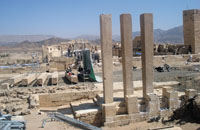
Throne of Balqis in Mareb. German archaeologists have been conducting excavation and restoration works in Yemen for 30 years now and have helped to preserve some of Yemen’s most valuable ancient sites. YT Photo by Salma Ismail. Once the capital of the kingdom of Queen Sheba, also known by her Arabic name Balqis, Mareb is now largely in a state of disrepair. Blocks of stone with Sabean writing bear testament to the rich history of the city. Writing in spray-paint also stands witness to the negligence of authorities to adequately protect this historical site which has been buried in the desert for over a millennium. Officials are calling for adequate security personnel to protect the sites while no excavation is being carried out. Most security personnel are Bedouins and do not understand the importance or the historical value of the sites. Mentioned in the Hebrew Bible, the New Testament, and the Qur’an, but only recently excavated, new information grows daily about Sheba and this temple city of the Sabaean kingdom, home of the legendary Queen, who was very influential, wealthy and famous during her rein, some 3000 years ago. The Bar’an temple Mahram Bilqis, or Temple of the Moon God, was a sacred site for pilgrims through Arabia from 1200 BC to 550 AD.Six columns mark the entrance to the “Throne of Balqis”, which is 15m (50ft) high and features a podium, a courtyard, a high wall and an irrigation canal. The temple was abandoned after 14 centuries when the kingdom’s subjects started to convert to Judaism and Christianity. Southwest of Mareb is the ancient Mareb Dam, used thousands of years ago to irrigate the surrounding land. The destruction of the Marib Dam around AD 570 sealed the demise of the kingdom after which large numbers of people emigrated northwards. The stonework is still impressive, measuring 600m (1968ft) wide and 18m (60ft) deep.Mareb, which was named in 1000 B.C, is located 172 km east of Sana’a, is considered to be one of Yemen’s richest archeological sites.Landmarks of the city include the prime temple located in the southern part of the city; the temple exemplifies the Maeenian architecture, having 16 vertical and horizontal columns, formulating a grid-shape. Researchers believe that this temple was built for the worship of Athtar, the sun god. There is also another temple in the heart of the city of which four columns can still be seen. The German Archaelogical Institute (DAI) together with the Yemeni General Organization of Antiquities and Museums (GOAM) have been conducting an excavation and restoration of the ancient Sabaean town of Sirwah in the Yemeni province of Ma’rib since 2001. In March 2008 their work led to the discovery of an ancient, well-preserved Sabaean temple dating back to 7th century BC. according to Dr. Iris Gerlach, Director of the DAI in Sana’a. The discovery was made during excavation works in the ancient Sabaean town of Sirwah, at the central province of Marib. The large town was surrounded by a fortification wall, and included many monumental buildings, of which the most prominent is the al-Maqah Temple, a sanctuary that dates back to the 7th century BC, and is currently undergoing restoration. During the restoration work at the al-Maqah Temple, the DAI team discovered ‘another unique and well preserved Sabaean temple as part of the ancient town.’ The sacred building has a monumental entrance decorated with pillars and different rooms inside. The ground plan and the construction features of the temple are singular in Yemen; tower-like projections divide the exterior facade of the sanctuary and the building material consists of a phenomenal wood/stone construction, the DAI said. German archaeologists have been conducting excavation and restoration works in Yemen for 30 years now and have helped to preserve some of Yemen’s most valuable ancient sites. Other countries have also been involved in excavation in this saced area including, the US, Italy, France and Canada.A Germen Archaeological mission undertook excavation work at the temple site with the results indicating that the Temple is a square shaped structure with an open area in front of the six columns, with the center of the area occupied by the Holy well and its accessories. The stone basin is rectangular in shape, which is fed water by means on the western and northern sides envelop the Holy street .Walls on the southern, western and northern sides envelop the open area. There is a line of fixed marble seats connects this open area and the Quds, where the six columns stand on fixed foundations.Talks and studies of a museum in Mareb to preserve the ancient are underway and have been for quite sometime. However, until something concrete is done, it will remain talk. It is organized and funded by the Yemeni Social Development Fund, which receives foreign donations. Dr Iris Gerlach from the German Archaeological Institute said, “Nowhere in the world is an archaeological City totally excavated, there will be something left for the next generation.”Many people have stolen beautiful valuable stones and used it to decorate their houses, which have been documented, in the hope of getting them to return the stones.On the four hour journey from Sana’a, on your way to the region where a woman once ruled, you will probably see a lot of men, not many women except the German archaeologists of course. A high-ranking official, when asked how they would feel if woman power was restored and another woman were to rule the region. He said, “We are not satisfied with the ruling of men, how could we be satisfied with that of a woman?”